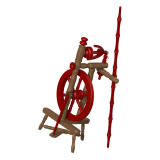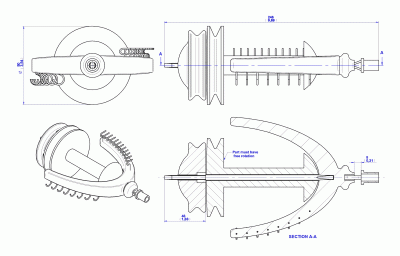We give you here the free plan of an authentic functional castle spinning wheel, a convenient tool to start spinning yarn.
Today, fabric is part of everyday life, and because it's available and has affordable price, we don't pay special attention to fabric's origin. That is due to well developed industry that has moved production of fibers and fabrics from the homes of people to the factories where production was done by machines. However, throughout whole human history, up to 200 years ago, spinning and weaving was women's responsibilities in every family and it took whole day, because that was the only way to provide clothing for family members. It was entirely handmade. Even after introduction of industrial machines in the factories, poor people continued to handmade threads and fabrics. Wool spinning and hand knitting of the woolen garments continued to exist till today. The only difference is that with time it has grown from necessary need to a respected craft. Hand-knit sweaters made from hand-processed wool are now highly valued and more expensive than industrial ones. And they always have their buyers.
A spinning wheel is a device used for centuries to twist or spin fibers into a continuous thread or yarn that's been later used in fabrics weaving. Long time ago people had discovered that twist makes the short fibers to hold tightly together and to not separate, and that twisting can make long threads that are much firmer and that won't tear. These types of threads have enabled fabrics making and sewing.
Chahges of this plan were made on: May, 2015
The changes are made on: Flyer subassembly drawings, Parts: 2.01 Flyer bearing, 2.02 Flyer and 2.03 Flyer axle

433mm (17.05'') x 340mm (13.39'') x 843mm (33.19'')
Model that was used in the making of this plan, a hundred years ago was used by our grandmothers for wool spinning which was later on used for sweaters and gloves knitting. Because of model's authentic origin, you can have confidence in our plan that it's not just precisely technically made, but also that your spinning wheel will be complete, with all necessary parts, functional, and that you can use it for spinning. When you don't use it, you can keep it as a decoration. This is Castle model spinning wheel and it comes from the territory of the former Austro-Hungarian Empire and still it can be found as a family legacy in rural households.
Here you have one of our more complex projects. It contains nearly 50 different parts. It's made of wood, and just those necessary parts are made of metal. Construction is based on mortise and tenon joints, and in assemblage instructions it is pointed where to use glue. To create our spinning wheel you need to have adequate tools, solid experience in wood processing and enough time and patience for production of this very complex project. The result will be unique, useful and very valuable item.
To create a spinning wheel, you need high-quality hardwood, without knots and defects. Most parts are made by using a lathe for processing of wood and for making this type of spinning wheel you need a solid experience in woodturning. Wood that will serve you well in the production is Maple, cherry, walnut, European alder, birch, beech or some similar type of local hardwood. It is often used at least two or three kinds of wood, in order to increase spinning wheel esthetic value. We emphasize that you should pay special attention to sanding the parts, because they often come in contact with hands and by doing this, you will avoid injuries from wood splinters. Finishing depends entirely on your wishes. You can leave spinning wheel unfinished, you can use transparent varnish or color, whatever you wish.
The spinning wheel assembly is classified into the three subassemblies:
1. Wheel Assembly
2. Flyer Assembly
3. Frame Assembly
The history of fibers spinning is twined with history of mankind. Wherever there is historical evidence of early man there also has been evidence of spun threads or tools that were used for spinning. In the early history people had spun vegetable and animal fibers and made fabrics out of them. It is not known when people began to twist fibers into threads, but archaeological evidence points that twisted threads had existed in Upper Paleolithic era, 20.000 years ago. Initially, it was entirely done by hand, and later on people began using spindle. Spindle whorl existed in Neolithic era, 10.000 years ago, and it was for used thousands of years, evidenced by its finding in archaeological sites worldwide. Spinning was extremely hard work, that took a lot of time and that was done only by the female family members. In the Middle Ages with the increase of population, weavers needed more and more yarn and women with spindles were unable to spin sufficient amount of yarns. The spinning wheel was the tool that accelerated process of threads production, and enabled us to take fabric and garments production to a higher economic level. Spinning wheel enabled textile industry to become one of the key industries in the Middle Ages. Agriculture was the only industry that had more significance than textile industry. The importance of fabric production has led to discovery of tools for mechanization regarding that process in the 18 century, and it initiated the whole industrial revolution which had changed the world in the next 200 years and led to the progress of civilization more than it happened tens of thousands years earlier.
We can not say for sure where and when spinning wheel was developed, because it seems that in several places in the world simultaneously had come to the improvement of spinning process by developing helping tools that later on lead to the development of spinning wheel. However, most often referred countries are India and its process of cotton spinning and China and its process of silk and ramie spinning. Some states are saying that spinning wheel was developed in India between 500 and 1000 A.D., while some assume that spinning wheel appeared in China in the 6th century A.D., and according to other sources, much earlier. It is known that in the 11th century it was widely used in China. In Europe it was used from the 13th century, and from the 17th century it was already commonly found in immigrants homes in North America.








Today spinning wheel has become interesting again, but not because its necessity in the production of yarn, but because of the need of modern man to maintain connections with their past, with the lifestyle of their ancestors, to cultivate the tradition, but also to engage in handicrafts that are certain way to escape from busy everyday life and stress into rest and relaxation. The need to maintain connections with the past and need to return to the nature influence more and more people to keep spinning wheel even as a decoration, because it has beauty of the past times. Today, we can notice significant interest for handmade spinning wheel and the spinning we can do on them. Unfortunately, the number of people that have used spinning wheel for fibers spinning as a routine, not just as a hobby in their life, and who can, at first hand to give instructions on how to use spinning wheel and how it should looks in order to be fully functional, decreases.
For spinning we can use different types of vegetable and animal fibers, such as wool, hairs, flax, hemp, ramie and other. Since different fibers are highly variable in characteristics such as length, strength, structure and quality, for their twisting is necessary to use different accessories, bobbins, and often fully different spinning wheel. Since today, when we talk about spinning, we often refer to wool spinning, which is the easiest to be spin from all the mentioned fibers, it is good to know that beside experience and good spinning wheel, wool quality strongly affects spinning- whether it will be easy or complicated. Wool has to be well prepared, cleaned, washed and it is always easier to spin raw, naturally white wool that the colored one. From the personal experience I know that, under mentioned conditions, it takes half an hour to practice coordination of movement and to master basic techniques of the work on the spinning wheel. Everything that comes after that step is training, work speed practicing and practicing the way to achieve desirable quality, firmness and strength of spun fiber.
Based on the general look, there are few different types of spinning wheel. Basically, all of them are very similar, the difference is in the position of certain parts and in the size, but those parts still have the same function. The basic types are Saxony wheel (horizontal type) which is considered to be traditional model, Norwegian wheel (horizontal on a bench) similar to Saxony wheel, and Castle wheel (vertical type), also known as Upright wheel, whose plan we present here, ideal for the spinners who need wheel for the common transport, because Castle wheel is more compact than majority of other models. Beside them, we can also find various forms of so-called “modern“ wheels.